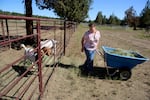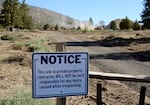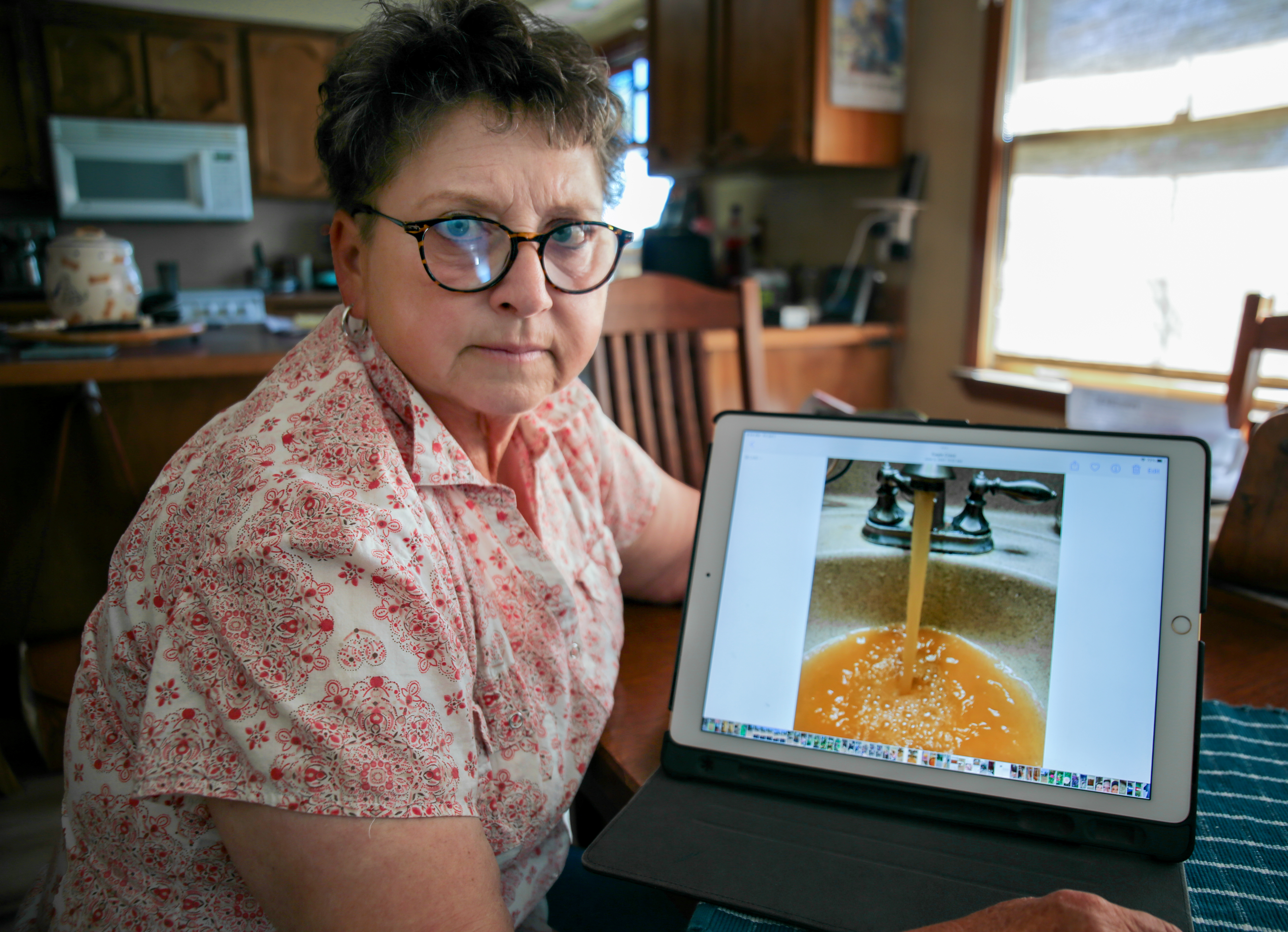Editor’s note: This is the third story in a series about how Oregon officials managing groundwater supplies have fueled crises and inequities, leaving the state ill-prepared to meet the growing challenges of drought and climate change.
When Susan Burdick hunted for a Central Oregon home to buy in 2006, she looked at dozens of listings without landing any of them. Then one night, the realtor called about a property around 5 miles southwest of Redmond. Burdick hopped in the car.

Susan Burdick feeds goats Rose and Miley at her home in Deschutes County, Ore., on July 1, 2022. The population is booming as groundwater is declining.
Emily Cureton Cook / OPB
“This is it,” she remembered thinking.
The 5-acre tract was just what she’d been seeking: a modest country home with plenty of space for her priorities — horses, dogs, chickens, goats and a garden.
“It’s not fancy,” she said. “But, it’s my little paradise.”
Then her well ran dry in 2020.
Paying the price
Burdick had no running water for weeks as she waited for a drilling company with a monthslong backlog. She was ultimately saddled with more than $30,000 in costs.
“It was a nightmare,” she said. “And the story just gets worse.”
Burdick is among the Oregonians paying the price of declining groundwater in the state’s fastest-growing region. Over the past 10 years, Deschutes County residents have deepened an average of 29 wells per year. Last year, that shot up to 60, and so far this year the problem is worse. Meanwhile, development is booming, with more than 1,100 new wells drilled since 2020 alone.
State regulators have long taken a timid approach to safeguarding groundwater for domestic wells, which aren’t regulated like larger commercial or agricultural uses. People who complain about dry home wells are often told that the only recourse in state law is to keep digging deeper.

Aiken Well Drilling operators bore a domestic well at a new rural home site about ten miles east of Bend, Ore., July 5, 2022.
Emily Cureton Cook / OPB
Even in the upper Deschutes, one of the most regulated river basins in the state, lawmakers and officials have focused on appeasing rather than reining in wealthy developers who are allowed to buy groundwater rights in one place and then extract that water from miles away, where aquifer levels are dropping at alarming rates.
Moving water
The groundwater problems in the dry, high desert of the upper Deschutes aren’t a surprise. More than a decade ago, state and federal scientists charted the trend and predicted it would continue.
Still, Burdick can see the dust rising from construction on a luxury development a mile or so down the road from her home.

Public land surrounds the Thornburgh destination resort site in Central Oregon's Deschutes County, where a construction is underway amid legal challenges to the project's water rights.
Emily Cureton Cook / OPB
Over the years, the plans for the nearly 2,000-acre Thornburgh resort have included three golf courses, private lakes, more than 400 overnight lodging units and nearly 1,000 single-family homes. Deschutes County officials approved that land use despite staunch public opposition.
Much of the pushback stems from how much water the greened oasis would require. And since all water in Oregon is publicly owned, a state agency regulates how and where it’s used.
In 2013, regulators initially agreed Thornburgh would be allowed to pump up to nearly 6 million gallons per day from wells. Annually, the resort could take as much water as the city of Prineville, population 10,000, reported using last year. Under this permit, up to a third of Thornburgh’s water could go to golf courses.
But when construction didn’t happen in a five-year period, that opened the resort’s water permit up to a legal challenge. And a lot has changed since 2013. The state is studying more of the crises it’s created by approving too many wells, and officials are grappling with how to plan for climate change and population growth. In response to those changes, water regulators have promised to be more cautious about groundwater.
Caught in this shift, Thornburgh developer Kameron DeLashmutt has been pursuing a different strategy for getting water — buying and moving millions of dollars worth of existing water rights from elsewhere in the basin, to the resort.
“I have tremendous amounts of water rights,” he said. “We have water secure.”
DeLashmutt said he’s in the process of scaling back the water footprint, calling Thornburgh “the most environmentally friendly, most ecological project that’s ever been built in the West.”

Plans for the Thornburgh resort over the years have included three golf courses, private lakes, more than 400 overnight lodging units and nearly 1,000 single family homes on nearly 2,000-acres.
MacGregor Campbell / OPB
One of the water rights DeLashmutt hopes to move to the site begins on a historic tree farm just outside Bend city limits, more than 13 miles from Thornburgh.
The tree farm became a subdivision of multi-million dollar homes around 2016. Its developers carved 50 lots onto more than 500 acres, converting most of the land into parks.
During construction, the city of Bend’s water utility absorbed the new subdivision, aptly called The Tree Farm.
But as Bend’s service area grew, the city didn’t get dibs on the property’s groundwater supply. Instead, the water right went up for auction, and the city was outbid.
The Tree Farm developer, Brooks Resources, solicited sealed offers in 2020. (Editor’s note: Brooks Resources, as well as its board chairman Mike Hollern, are financial supporters of OPB.)
“As a developer, this is not new for us,” said the company’s President and CEO Kirk Schueler.
A lot of land in Central Oregon has been added to municipal systems, he said, leaving water rights to be sold separately.
In this case, Bend’s bid of $225,000 wasn’t enough. Schueler declined to share the winning figure or details about the buyers.
State records show two entities are in the process of divvying up portions of the Tree Farm’s water right. One of them, KC Development Group, hopes to make groundwater the centerpiece of “Central Oregon’s only private water ski community,” according to its marketing website.
Pumping would fill two lakes, one of them the length of six football fields, located about 3.5 miles away from the original Tree Farm well.

A privately owned water ski lake at the Tanager subdivision near Bend has sparked years of lawsuits between neighbors, and an ongoing legal challenge against state regulators who approved transferring a groundwater right for the lake in 2021.
Emily Cureton Cook / OPB
The other buyer is DeLashmutt’s company, Pinnacle Utilities, which seeks to move a cut of the water right to Thornburgh’s site temporarily, and pump up to 300,000 gallons a day for the next five years of construction at the resort.
Through the Tree Farm’s auction, both Thornburgh and the private water ski lake got approvals, with regulators noting in one review that under Oregon law, groundwater rights are moved to new locations without considering what’s in the public interest.
Warning signs
Near where Thornburgh lies, the water level in monitored wells has been shrinking more than a foot per year for decades, state data show.
“The declines are starting to become significant,” Oregon Water Resources Department Deputy Director Doug Woodcock said. “And it’s not going away.”
From the Bend area, northward to Redmond and Lake Billy Chinook, state hydrogeologists have said climate changes and pumping by humans are driving as much as 90% of the downturn. The piping of irrigation canals is thought to play a smaller role in some areas.
It can take decades or longer for rain and snow falling in the Cascade mountains to seep underground and flow down to aquifers in valleys, according to U.S. Geological Survey Research Hydrologist Stephen Gingerich. Studies have long shown how this slow-moving groundwater system is intimately connected to springs and rivers gushing on the surface.
The Deschutes basin is the only place in Oregon where special rules require people who drill new municipal, industrial, or irrigation wells to mitigate their impacts on streams, usually by buying water rights elsewhere and retiring them. This 20-year-old mitigation program also caps the total amount of new groundwater rights the state can approve, fueling a hot market for those who can afford to buy into the region’s limited supply.
But the regulations have not stabilized water levels underground.
Eventually, according to a 2021 state memo, the declines will catch up to some of the region’s iconic spring-fed surface waters — like the Deschutes and Crooked rivers.

The Upper Deschutes River near Bull Bend outside La Pine, Ore.
Brandon Swanson / OPB
The memo set off alarms that in some areas within five to 10 years the aquifer could meet the legal definition of “excessively declined,” a benchmark that would push regulators to impose cutbacks.
These warning signs are in a region where more and more people are moving. Deschutes County’s population spiked more than 25% over the last decade. Statewide, regulators are promising to impose stricter rules on new groundwater development, possibly as early as next year.
There are signs Oregon may be changing course on how freely people can pump, after mismanagement has created crises in rural communities, like Harney County in Eastern Oregon. But even there, where too much pumping threatens basic survival needs, regulators have not reined in existing water rights or stopped people from transferring water rights to extract groundwater in areas where wells are going dry.
A former OWRD planner, Harmony Burright, recently told state auditors that the agency’s approach has left many Harney County residents “completely jaded by any attempts to have their voice heard in the water rights transfer process,” and that “the public process is fundamentally broken.”
In fast-growing Central Oregon, Thornburgh may be a testing ground for how far regulators are willing to go to correct a permissive past, and how they will respond to wealthy interests that seek to exert political pressure.
Recently, the Oregon Water Resources Department had denied multiple applications for Thornburgh to drill wells, calling them “detrimental to the public interest,” and saying “water will likely not be available within the capacity of the resource.”
But regulators changed their minds when Thornburgh scooped up the Tree Farm water rights.
When a neighbor to Thornburgh sued the state to block the transfer, DeLashmutt said in an interview his development was being victimized by the “ongoing weaponization of water law by the project’s opponents.”
He argued that the resort wouldn’t harm neighboring wells, according to experts it hired in 2005.
“There’s a great big bucket down there, and we’re taking a cup out of it,” he said.
But because of the concerns, Delashmutt said in an email that he’s promising Thornburgh will pay to “address and correct well issues it caused,” within a two-mile radius of the site.
The promise of water
Complex procedural maneuvering is nothing new for one of Thornburgh’s staunchest opponents, Nunzie Gould. She lives a few miles from the site and has been diligently opposing its various land and water permits since 2004.
“We could all just keep drilling our wells deeper, but that’s not a solution to how we manage water here,” Gould said.
Her protest is currently stalling Thornburgh’s 2013 permit, and she’s the plaintiff blocking the Tree Farm water right sale, for now.
“It’s not about me. It’s about how we steward our public resources,” she said.
On a blistering June day, Gould hiked around the public lands bordering the construction site, talking about local history, and what happened here before Oregon’s water belonged to the public.

Nunzie Gould has long been an active opponent of plans for the Thornburgh destination resort in Deschutes County. "Ecologically, it's not sustainable," she says. "Wells are going dry."
Emily Cureton Cook / OPB
“This land was supposed to be settled, but water never came,” Gould said, taking shade under a juniper tree, and pointing toward a maze of dry ditches that date back more than a century.
She sees these relics as a warning of her current battle against Thornburgh.
In the early 1900s, private developers lured white settlers to this area by advertising things like “free water,” and an “immense water supply.” A developer named William Laidlaw promised his company would divert a stream to build a vast canal system and turn the high desert green. This irrigation project would be “one of the best in the West,” according to a 1907 ad in the Bend Bulletin.
But even as Laidlaw and his shareholders turned large profits from buyers, the company delivered just a fraction of the promised water. It continued to sell more land for development.
The conflict ultimately fueled a political movement to protect “the little people,” according to historian Martin Winch. It set the backdrop as Oregon lawmakers passed the state’s water code in 1909, codifying water as a public resource for the first time.
As for Laidlaw’s swindle, those taken in by it were so upset they reportedly hung effigies of the developer — twice — and they changed the name of the town he platted from Laidlaw, to Tumalo.
“There’s long been a promise of water as a marketing tool for settlement and development here,” Gould said.
“One of the key differences between then and now is the extraction of groundwater.”

Gould studies a map of Thornburgh which is being constructed near her home, June 22, 2022. She has spent nearly two decades opposing the plan. "It's not about me," she says. "It's about how we steward our public resources."
Emily Cureton Cook / OPB
Playing politics
Faced with Gould’s latest legal roadblocks, Thornburgh’s lawyers got more creative. This year, they recruited seven state lawmakers to back DeLashmutt’s cause.
In May, the lawyers proposed a deal, one that would leverage the developer’s portfolio of senior water rights against state officials’ eagerness to aid desperate farmers.
Thornburgh attorney Janet Neuman sent a May 16 letter to the director of the state Water Resources Department, Tom Byler, and Oregon Gov. Kate Brown with a proposal to get around Gould’s lawsuit.
“The purpose of this letter is to suggest an additional reason for lifting the stay, one that has substantial public benefit, whereby DeLashmutt and Pinnacle Utilities are willing to allow millions of dollars of water rights they own, to be used by drought-stricken farmers free of charge,” Neuman wrote.
The offer appeared to tie the resort’s controversial groundwater battle to an unusual trade: a one-time donation of unrelated surface water rights to help farmers facing ruin about 40 miles away from the resort, in Jefferson County’s North Unit Irrigation District.
The resort’s lobbyist, Rocky Dallum, approached numerous state lawmakers about the idea. The Legislature controls the Oregon Water Resource Department’s budget, and the governor appoints its director, who serves at her pleasure.
“Hopefully you would be willing to talk with OWRD, the Governor (who’s currently looking for ways to help farmers in drought) and others,” Dallum wrote to several lawmakers involved in water policymaking.
On May 26, five representatives and two senators sent Byler and Brown a letter of their own. It advocated for water swaps as a way to relieve drought-stricken areas and lists just one specific case number: Thornburgh’s.
“It has come to our attention that a proposal has been made on a temporary water right transfer,” the letter states. “Measures such as this proposal have the potential to free up significant volumes of water,” the lawmakers continued, saying they “stand ready to support water sharing that can help keep farmers in business during severe drought.”
The first draft originated with a Democrat from Washington County, Rep. Ken Helm.
In a rare display of bipartisan agreement, it was co-signed by five Republicans and one other Democrat, including Republican minority leader Vicki Breese-Iverson, R-Prineville, Rep. Mark Owens, R-Crane, Rep. Daniel Bonham, R–The Dalles, Sen. Lynn Findley, R-Vale, Sen. Tim Knopp, R-Bend, and Rep. Jason Kropf, D-Bend.
Kropf later backpedaled and distanced himself from the letter. Owens and Helm defended it, denying it was based on materials provided by Thornburgh’s lobbyist on May 16.
“We saw an opportunity to get the water resources department to try to realize, ‘How can we be more flexible in water management?’” Owens said.

Rep. Mark Owens, R-Crane, on the House Chamber floor at the Oregon State Capitol in 2021 in Salem, Ore.
Kristyna Wentz-Graff / OPB
The water department did not respond to the lawmakers’ letter, according to Byler.
“We understand it to be an acknowledgment of the severe drought challenges in the basin and an encouragement to find innovative solutions, not a request for a response " the OWRD director said in a statement.
Only after these legislators championed Thornburgh’s proposal as a model for voluntary water-sharing did a major problem become obvious: The farmers who would supposedly benefit were the last to know.
Free water
Farmers in the North Unit Irrigation District sell far more crops than anywhere else in Central Oregon. The water for those crops comes piped and channeled from the upper Deschutes Basin. In fact, about 90% of all the water people use in this basin gets diverted through a series of reservoirs and canals serving eight irrigation districts.
When dry times hit, North Unit farmers are the first to lose access to this water due to their junior water rights. Nonprofits and state and federal lawmakers have long been brokering agreements to make it more palatable for irrigation districts with senior rights to share — including public funding for more than $125 million in infrastructure projects since 2017.
But DeLashmutt’s offer of free water didn’t sit well with North Unit’s executive manager Mike Britton.
He said the particulars reached him second hand, only after lawmakers took a position. He questioned the logistics of the offer and the motive.
“I think [Thornburgh] is probably using North Unit as a pawn in the process,” Britton told OPB several weeks after the proposal surfaced.
“Somebody figured out that North Unit is in a dire situation, and people are grabbing at everything they can to save their livelihoods and be able to farm,” he said.

A wheel line irrigation system crosses a field in Jefferson County, near Madras, Ore., in May 2022. Years of water shortages have challenged farmers in the North Unit Irrigation District.
Emily Cureton Cook / OPB
DeLashmutt denied any attempt at a quid pro quo with state officials.
“I suppose you could try to turn me into a bad guy, but given the facts, I’ve got water, it’s worth a lot of money and I’m willing to let people that really need it, use it,” he said.
On June 27, more than a month after lawmakers became involved, Thornburgh lobbyist Dallum assured Britton in an email that the resort “is not seeking compensation, consideration or any position on the development.”
At this point, the irrigation district signaled it would accept a one-time water donation, with some caveats.
“We’ve made it clear we want no association with Thornburgh,” Britton said in an email.
He was also doubtful the state’s administrative process would move fast enough to see any additional water this summer, which marks a third consecutive year of severe drought.
Old laws
North Unit Farmer Cate Havstad-Casad sees Thornburgh as emblematic of deeper injustices embedded in state water law, and the regulations enforcing it.
Her family grows organic crops and raises animals near Madras. This season they’re expecting a 75% reduction in the amount of water their properties are entitled to on paper.
“We sincerely hope that there is some common sense that is going to look at the inequitable distribution of water, and work to redistribute it,” Havstad-Casad said.
She testified before lawmakers last year, pleading for reforms.

Cate Havstad-Casad holds frozen meat produced by her family farm in Jefferson County. After years of specializing in organic vegetables, water shortages are driving Havstad-Casad and her husband to make a costly shift to grazing and meat production, she said. May 11, 2022.
Emily Cureton Cook / OPB
Like Oregon, many Western states use a system for dividing up water called prior appropriation. People who control the oldest water rights get their share first when supplies are scarce. It doesn’t matter if someone is using the water to grow food, maintain a private water ski lake, or build a golf course resort.
“The message that it sends is it doesn’t matter if farmers disappear,” Havstad-Casad said.
Even illicit cannabis grows are considered a “beneficial use” by Oregon water regulators, so long as the property they’re on has a valid water right for irrigation. To irrigate, state officials said, means simply to apply water to promote growth.
But some legal experts argue state regulators have more power than they’re willing to use.
University of Oregon law professor Adell Amos formerly served as a federal land and water resources attorney for the U.S. Department of the Interior. She said current state laws leave a lot of discretion with the state agency.
“It’s not that the law is perfect,” she said. “But there is a lot of unexercised authority there to address these issues in the face of climate change.”
For instance, regulators do have to consider public benefits when they look at applications to move or change surface water rights. But when developers want to move a groundwater right, like what Thornburgh and the water ski lake owners are doing, it doesn’t trigger the same type of review.
Career water managers in Oregon have the power to bring groundwater right moves more inline with how the state treats surface water, according to Amos.
“The road is really wide,” she said. “You have to politically choose where you want to be on that road.”

Two turkeys follow North Unit Irrigation District farmer Cate Havstad-Casad around at her family's farm near Madras on May 11, 2022.
Emily Cureton Cook / OPB
Overall, she said, there’s unresolved tension in how Oregon officials interpret the law to balance a public water supply against private property rights.
“It makes us an easy target,” she said. “If you’re a powerful interest that wants to privatize water and pump groundwater, why wouldn’t you pick a state where this is all muddled?”
Growing demand
When it comes to ensuring rural residents have access to groundwater for their homes, the burden is increasingly falling to taxpayers.
This summer, the state began funneling more than $5.5 million to certain homeowners with failing wells.
“We get multiple calls a day about dry wells,” said John Cox, the lending director at the Central Oregon community aid organization NeighborImpact. “It’s just unprecedented.”
Last year, Cox said the nonprofit serving three counties made loans to replace 18 wells for low-income households, at a total cost of more than $400,000.

Aiken Well Drilling's Neil Fagen is splattered with wet sand as he works to build a domestic well east of Bend, Ore., July 5, 2022.
Emily Cureton Cook / OPB
This year, an infusion of state grants are expected to go further, but with each well project averaging a cost of $23,000, Cox predicted the money “will be gone in no time.” And there’s no certainty the Legislature will reauthorize the funding in 2023.
In July, water regulators shot down another one of Thornburgh’s requests for wells.
DeLashmutt has said he’s confident that he’ll be able to get the water he wants.
And the resort is poised to grow. DeLashmutt is in the process of trying to buy 400 acres of state property inside the resort’s existing footprint, with the Oregon State Land Board expected to take up the issue again in August.
Burdick, the homeowner whose well went dry about a mile away, is worried.
The first time she paid to drill deeper, the water that came back up wasn’t the same quality as before. It flowed dark yellow from the tap, she said.

Susan Burdick shows a picture of what her tap water looked like after she paid to build a new well at her home in Deschutes County, Oregon in August 2020. Months later, she paid to drill deeper in order to improve the water quality. July 1, 2022.
Emily Cureton Cook / OPB
She had to pay more to keep drilling. And now, she said, she can’t afford another round. She lives with a serious illness and makes ends meet on a fixed income. She’s skeptical of the developer’s promises to pay to deepen peoples’ wells.
“I just don’t know how long it’s gonna take for my straw to not be long enough,” she said. “Thornburgh has the money to run the longest straw of any of us.”
She described herself as a conservative, someone who usually votes for Republicans and who strongly supports private property rights.
But, she said, there should be limits: “You can’t just keep sucking water out of the ground and let everybody else lose.”
Correction: A previous version of this story understated the number of gallons per day the developer of the proposed Thornburgh resort is seeking through a pending water right transfer from the Tree Farm. OPB regrets the error.

